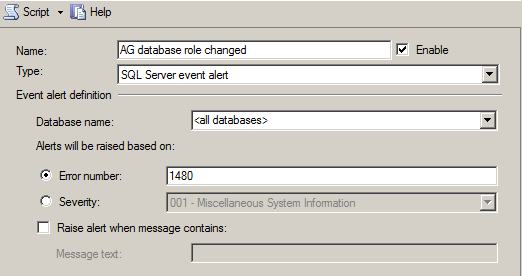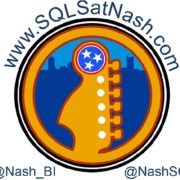Where is my Availability Group Primary Replica?
In SQL Server 2012 we got this new high availability feature called availability groups. With readable secondaries under the covers, it can be harder to figure out the answer to the following two questions. When did the availability group failover? Where did the availability group go when the failover occurred? The goal of this blog post is to help simplify answering these questions.
Availability Group Extended Event
One of the things we really like about Availability Groups is that there is a built-in extended event named “ALwaysOn_health†that runs and captures troubleshooting information. We took a look at the extended event and noticed that there are several error numbers that were included in the filter for this extended event. This is shown below as we scripted out the default extended event for a quick review.
CREATE EVENT SESSION [AlwaysOn_health] ON SERVER
ADD EVENT sqlserver.alwayson_ddl_executed,
ADD EVENT sqlserver.availability_group_lease_expired,
ADD EVENT sqlserver.availability_replica_automatic_failover_validation,
ADD EVENT sqlserver.availability_replica_manager_state_change,
ADD EVENT sqlserver.availability_replica_state_change,
ADD EVENT sqlserver.error_reported(
WHERE ([error_number]=(9691) OR [error_number]=(35204) OR [error_number]=(9693) OR [error_number]=(26024) OR [error_number]=(28047)
OR [error_number]=(26023) OR [error_number]=(9692) OR [error_number]=(28034) OR [error_number]=(28036) OR [error_number]=(28048)
OR [error_number]=(28080) OR [error_number]=(28091) OR [error_number]=(26022) OR [error_number]=(9642) OR [error_number]=(35201)
OR [error_number]=(35202) OR [error_number]=(35206) OR [error_number]=(35207) OR [error_number]=(26069) OR [error_number]=(26070)
OR [error_number]>(41047) AND [error_number]<(41056) OR [error_number]=(41142) OR [error_number]=(41144) OR [error_number]=(1480)
OR [error_number]=(823) OR [error_number]=(824) OR [error_number]=(829) OR [error_number]=(35264) OR [error_number]=(35265))),
ADD EVENT sqlserver.lock_redo_blocked
ADD TARGET package0.event_file(SET filename=N'AlwaysOn_health.xel',max_file_size=(5),max_rollover_files=(4))
WITH (MAX_MEMORY=4096 KB,EVENT_RETENTION_MODE=ALLOW_SINGLE_EVENT_LOSS,MAX_DISPATCH_LATENCY=30 SECONDS,MAX_EVENT_SIZE=0 KB,MEMORY_PARTITION_MODE=NONE,TRACK_CAUSALITY=OFF,STARTUP_STATE=ON)
GO
SQL Server Availability Groups got us interested in learning why these specific errors are included in the extended event session explicitly created for managing Availability Groups. Knowing that the descriptions for messages are in the sys.messages table, we did a little digging.
System Messages
Taking the error numbers from the AlwaysON_health extended event we were able to build the following query to get the description of the errors included in the extended event.
SELECT *
FROM sys.messages m where language_id = 1033 -- English
--AND m.message_id =1480
AND ([message_id]=(9691) OR [message_id]=(35204) OR [message_id]=(9693) OR [message_id]=(26024) OR [message_id]=(28047)
OR [message_id]=(26023) OR [message_id]=(9692) OR [message_id]=(28034) OR [message_id]=(28036) OR [message_id]=(28048)
OR [message_id]=(28080) OR [message_id]=(28091) OR [message_id]=(26022) OR [message_id]=(9642) OR [message_id]=(35201)
OR [message_id]=(35202) OR [message_id]=(35206) OR [message_id]=(35207) OR [message_id]=(26069) OR [message_id]=(26070)
OR [message_id]>(41047) AND [message_id]<(41056) OR [message_id]=(41142) OR [message_id]=(41144) OR [message_id]=(1480)
OR [message_id]=(823) OR [message_id]=(824) OR [message_id]=(829) OR [message_id]=(35264) OR [message_id]=(35265))
ORDER BY Message_id
Now we will focus on one particular error message. The error message 1480. Looking at the description below you will see that every time a database included in an availability group or database mirroring changes its role this error occurs.
The %S_MSG database “%.*ls†is changing roles from “%ls†to “%ls†because the mirroring session or availability group failed over due to %S_MSG. This is an informational message only. No user action is required.
When did my AlwaysOn Availability Group Failover?
By now it should not be a big surprise to see how you can figure out when your availability group failed over. To answer this question, we are going to filter the “AwaysOn_health†extended event for error_number 1480.
The “AlwaysOn_health†extended event target is to a text file, and by default, it will utilize the default log folder for SQL Server. Keep in mind, that by default the target does a rollover four times when a file reaches 5 MB for a total of 20 MB. If you continually have failovers occur data will get purged.
The server used for this blog post my path is “C:\Program Files\Microsoft SQL Server\MSSQL11.MSSQLSERVER\MSSQL\Log\†if this is not your path you will need to modify line 2 in the script below.
;WITH cte_HADR AS (SELECT object_name, CONVERT(XML, event_data) AS data
FROM sys.fn_xe_file_target_read_file('C:\Program Files\Microsoft SQL Server\MSSQL11.MSSQLSERVER\MSSQL\Log\AlwaysOn*.xel', null, null, null)
WHERE object_name = 'error_reported'
)
SELECT data.value('(/event/@timestamp)[1]','datetime') AS [timestamp],
data.value('(/event/data[@name=''error_number''])[1]','int') AS [error_number],
data.value('(/event/data[@name=''message''])[1]','varchar(max)') AS [message]
FROM cte_HADR
WHERE data.value('(/event/data[@name=''error_number''])[1]','int') = 1480
Below you will see an example of the result set which shows my last failover.

You could also utilize the Extended Event GUI to watch data. We will skip that today as we would recommend using T-SQL so you can find failovers in multiple Availability Groups on different servers. We will go into more detail about this process a little later in the blog post.
How Do We Become Proactive?
If you want an action to occur when a database inside an availability group changes roles to be proactive, you can configure an SQL Agent Alert. An SQL Agent alert can perform actions like sending an email to your DBA team or running another SQL Agent job to complete your required task.
The following shows you how to configure this alert via the SSMS user interface.

How Do We Report failovers across the Enterprise?
Central Management Server (CMS) is your best friend for building reports to show Availability Group failovers across the enterprise. You can create a CMS group for your SQL instances in your Availability Group and copy and paste the query above to detect Availability Group failovers.
NOTE: This assumes you have an standard install process that keeps the default log path the same across your SQL Server instances. We strongly encourage that you have an automated SQL Install process that keeps using the same path for all your installs but we will keep that blog post for another day.
Need more info on Building Your First Availability Group?
Join us for pre-conference training brought to us by SQL Saturday Nashville! John Sterrett will be presenting a half day precon in Nashville, TN on Thursday, January 11, 2018, from 1:00 pm to 4:30 pm!
In this half-day session, you will learn how to build your first availability group while also learning how availability groups work with other components like active directory, storage, and DNS. You will walk away with a checklist to help your future deployments while also learning how to implement, monitor, troubleshoot and use availability groups.
Space is limited so act fast and Register here now!







Leave a Reply
Want to join the discussion?Feel free to contribute!